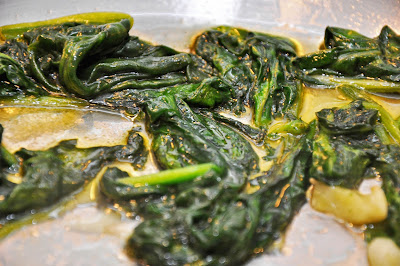Here's a 'master recipe' for one of the most common techniques in Italian cookery for preparing vegetables, particularly green, leafy vegetables. The technique is called rispassato in padella or saltato in padella which literally means 'tossed in the skillet' and could be translated simply as 'sautéed'.
As an example, spinach is a good place to start. If you are using very tender 'baby' spinach, simply rinse it well in water without drying it out. Then make a soffritto by very lightly sautéing a clove or two of garlic, slightly crushed, until it just begins to give off a bit of fragrance. If you're cooking for company, you can remove the garlic at this point for a more elegant presentation. But at home I just leave them in for extra flavor (and it wards off vampires, too).
Then add your raw spinach leaves with the water that clings to them, along with a sprinkling of salt.
Toss the spinach leaves well and they will quickly begin to wilt under the heat of the hot oil.
Allow the spinach to simmer and absorb the flavors of the soffritto for just a couple of minutes, until the spinach is well reduced and tender. Adjust the seasoning to taste.
And that's all there is to it!
Now, if you are using more mature spinach—the kind with dark green, crinkly leaves and thick stems—you should trim the leaves of their stems and blanch them for a minute or two in salted water before sautéing. They are easy to trim: just hold each leaf in your hand on each side of the stem. Then pull the stem off with your other hand—it should come off easily. Drain them before adding them to the soffritto. Some recipes, in fact, call for rinsing and squeezing them dry, but, except for specific uses where you really need a 'dry' vegetable (such as in a filling for stuffed pasta) I generally leave a little bit of moisture on the vegetable, and that's the way that Angelina used to do it.
NOTES: The same technique, as mentioned, can be used with just about any leafy vegetable. You can judge for yourself whether the vegetable needs pre-boiling or not: delicate greens like watercress generally do not, while most, including more robust greens like escarole, chicory, broccoletti (broccoli rabe) or kale, generally do. Pre-boil them until they are just a bit under-done, then transfer them to the skillet. Other vegetables can also be made this way, including broccoli, cauliflower, reen beans, peppers. And then there are other vegetables like funghi trifolati that have another name but use essentially the same technique, with some minor adjustments to account for the different textures involved.
Vegetables made this way make wonderfully simple but savory contorni to accompany grilled or roasted meats or fish. They can also star on their own as a light vegetarian second course. And they can go into other dishes, most commonly as a kind of condimento for pasta, as in dishes like orecchiette ai broccoletti, or as a component in a vegetarian stuffed pasta like lasagne in bianco.
When pasta is tossed in a skillet with a sauce, it is also sometimes called in padella—in fact, one of the most popular frozen prepared pastas in Italy is called Quattro salti in padella or 'four tosses in the skillet'. Other kinds of food can also be prepared in padella, in particular scallops, shrimp or calamari, but let's leave those dishes for another post.
